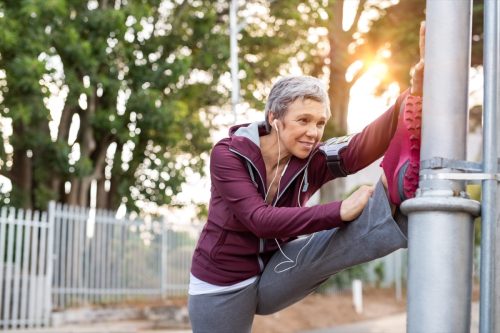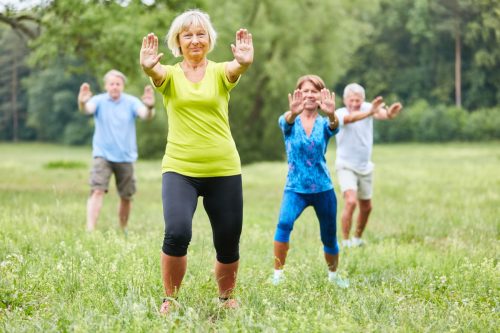How to Stay Active and Healthy in Your 50s and Beyond
These easy tips will help keep you healthy and happy.
Age shouldn't be an excuse when it comes to failing to prioritize your health. However, many people use it. "If you're active, healthy and over 50, you're way ahead of the curve! Congratulations," says Oliver Nam, owner and trainer of Thrive Training, in Irvine, California, who specializes in training older adults. "There are so many people out there who have given up on their health because of numerous reasons. Injuries…career has taken over their life…simply scared of the unknown." He offers 11 tips on how to stay active in your 50s and beyond.

Goal setting is a great place to start, encourages Name. "Understand where you are NOW with your body," he explains. He suggests spending some time identifying a few goals so you can set your milestones. "Small wins will keep you motivated and accountable."

He also suggests learning about the body before attempting to tackle health issues. "We have multiple subsystems that must function and communicate with each other to be performed optimally. Some you may know, some may be new. Regardless, each subsystem has its own responsibility to maintain a healthy functioning body," he explains. These include:
–Immune system
–Cardiovascular system
–Respiratory system
–Digestive system
–Excretory system
–Sensory system
–Muscular system
–Skeletal system
–Reproductive system
–Endocrine system
–Integumentary system
–Urinary system

Nam emphasizes the importance of hydration, recommending that you drink half your body in ounces of water. "Our entire body is made up of water: Your skin, your organs, your brain, even your bones," he says. "If you start counting how many ounces of water you actually drink in a day, you'd be surprised at how much you can improve your health by this simple act." According to the U.S. National Academies of Sciences, Engineering, and Medicine men should drink about 15.5 cups (3.7 liters) of fluids a day and women about 11.5 cups (2.7 liters) of fluids.

It may be tempting to take a vitamin or supplement, but Nam suggests eating whole and organic foods instead. "Our bodies were made to digest and absorb nutrients from real, whole food – that's how humans evolved for years," he explains. "Supplements are great, but people rely on them far too much for their health. Supplements are made for 'supplementing' your body only when necessarily needed, not as a substitution for whole and organic foods."

"Make sure to get full daily stretches several times a day," Nam says. This includes the legs, arms, and core. "Stretching keeps the muscles flexible, strong, and healthy, and we need that flexibility to maintain a range of motion in the joints," says Harvard Health. "Without it, the muscles shorten and become tight. Then, when you call on the muscles for activity, they are weak and unable to extend all the way. That puts you at risk for joint pain, strains, and muscle damage."

Focus on the fundamentals of strength training or resistance training, says Nam. "Do strength and weight training workouts at least three times a week and preferably at first with a trainer to make sure you get the proper form and technique; which is key to success and not hurting yourself."

Incorporating daily walks is a game changer for your health, says Nam. He suggests a minimum of 5,000 to 10,000 steps per day. One study published in JAMA Internal Medicine found that walking at a brisk pace for about 30 minutes a day led to a reduced risk of heart disease, cancer, dementia and death, compared with walking a similar number of steps but at a slower pace.

Make sure not to sit all day, says Nam. " Get up and move around."

Exercise doesn't have to be a solo activity. "Do group activities such as pickleball, golf, walking, and hiking," encourages Nam. "This keeps you accountable and more enjoyable."

Don't forget to get a little zen time in. "Take time to meditate or down regulate your body and mind," says Nam. "When you meditate, you may clear away the information overload that builds up every day and contributes to your stress," says the Mayo Clinic. Benefits include:
–Gaining a new perspective on stressful situations
–Building skills to manage your stress
–Increasing self-awareness
–Focusing on the present
–Reducing negative emotions
–Increasing imagination and creativity
–Increasing patience and tolerance
–Lowering resting heart rate
–Lowering resting blood pressure
–Improving sleep quality
RELATED: 2 Alternatives That Are Just As Beneficial as Walking 10,000 Steps

Finally, don't overlook the importance of sleep. "Make sure to sleep in a dark room and turn off all blue light (including cell phones and your television) at least 30 minutes before bed. "Getting proper rest and relaxation helps the body to reset and gives you energy so you can keep active," Nam says.






















